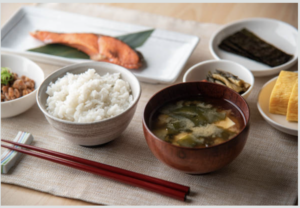The Charm of Japanese Breakfast: A Culinary Delight

When visiting Japan, one of the most delightful experiences is enjoying a traditional Japanese breakfast. Known for its balance, variety, and unique flavors, a Japanese breakfast is more than just a meal—it’s a cultural experience that provides a glimpse into the heart of Japanese culinary traditions. Whether served at a ryokan (traditional inn) or enjoyed at a bustling market, Japanese breakfast showcases a harmonious blend of taste, health, and artistry.
Historical Roots of Japanese Breakfast

Japanese breakfast has its roots deeply embedded in the country’s history and traditional dietary habits. The origins can be traced back to the Heian period (794-1185), when rice became a staple food. Back then, meals were simple and focused on rice, miso soup, and pickled vegetables. Over centuries, the format evolved, incorporating new ingredients and influences from other cultures while retaining its fundamental principles of balance and simplicity.
During the Edo period (1603-1868), breakfast became more structured, especially among the samurai class and urban dwellers. The concept of ichiju-sansai (“one soup, three dishes”) became the standard for a balanced meal. This tradition remains a foundation for Japanese meals, including breakfast, to this day.
Modern Japanese breakfast reflects both tradition and innovation. The inclusion of fermented foods like natto and tsukemono stems from centuries-old preservation techniques. Meanwhile, regional specialties, such as Hokkaido’s seafood-based breakfasts or Kyoto’s vegetable-focused dishes, highlight local ingredients and customs.
What Makes Japanese Breakfast Special?

A Balanced Meal: A typical Japanese breakfast often includes rice, miso soup, grilled fish, pickles, and a small side dish. This combination ensures a perfect balance of nutrients, flavors, and textures. Each component is thoughtfully prepared to enhance the overall harmony of the meal.
Focus on Seasonal Ingredients: Japanese breakfast highlights fresh and seasonal ingredients, reflecting the philosophy of harmony with nature. From spring’s tender bamboo shoots to autumn’s hearty mushrooms, the seasonal touch adds depth and meaning to every bite.
Aesthetic Presentation: The meticulous arrangement of each dish creates a visually pleasing experience that reflects the importance of beauty in Japanese culture. Traditional ceramics and lacquerware further elevate the dining experience, making it as visually satisfying as it is delicious.
Healthy and Satisfying: Rich in proteins and light on processed ingredients, Japanese breakfast is both nutritious and filling, offering a great start to the day. The inclusion of fermented foods such as natto or pickled vegetables promotes gut health, a cornerstone of Japanese wellness.
A Japanese breakfast is an ideal way to start your day while immersing yourself in Japanese culture. Whether you try it at a traditional inn or join a cooking class to make it yourself, the experience is sure to leave a lasting impression. Additionally, learning the techniques behind these dishes can offer a deeper appreciation for the craftsmanship involved. Why not begin your morning the Japanese way and savor the charm of this culinary tradition?
